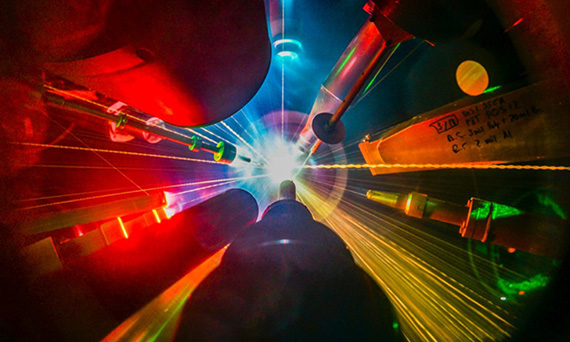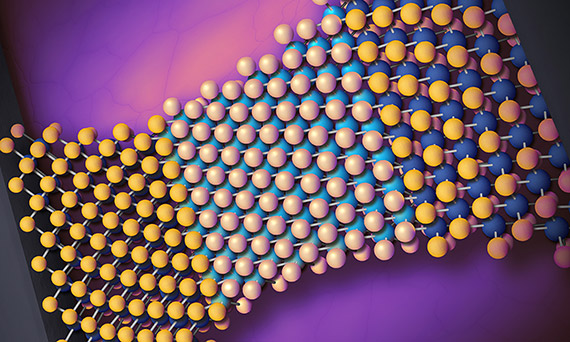|
|
|
|
See you in the new yearThis is the last edition of Research Connections for the year. We’ll be back in 2024 with a new look and fresh approach to research communications.
Laser Lab heads new national inertial fusion energy hub
View from inside the OMEGA target chamber during a direct-drive inertial fusion experiment at the Laboratory for Laser Energetics. (University of Rochester Laboratory for Laser Energetics photo / Eugene Kowaluk)
The University of Rochester’s Laboratory for Laser Energetics (LLE) has received a four-year, $10 million award from the US Department of Energy’s (DOE) Office of Fusion Energy Science (FES) to lead a national research hub dedicated to advancing inertial fusion energy (IFE) science and technology.
The LLE-led inertial fusion energy hub—named IFE-COLoR, which stands for Inertial Fusion Energy-Consortium on LPI (laser-plasma interaction) Research—is one of only three such hubs in the nation selected by the DOE through competitive peer review. The award is part of a recent DOE initiative to stimulate IFE research and development by building on the momentum of scientists’ breakthrough in achieving ignition, or a fusion reaction that creates a net energy gain, last year.
“As the world’s foremost academic center in these fields, LLE is well-suited to lead this new hub and advance fusion energy to help build a future powered by abundant and clean fusion energy,” says Stephen Dewhurst, the vice president for research at Rochester.
Learn more about IFE-COLoR.
Straining memory leads to new computing possibilities Artist’s rendering of a 2D material strategically strained to lie precariously between two different crystal phases. (University of Rochester illustration / Michael Osadciw) Artist’s rendering of a 2D material strategically strained to lie precariously between two different crystal phases. (University of Rochester illustration / Michael Osadciw)
By strategically straining materials that are as thin as a single layer of atoms, Rochester scientists have developed a new form of computing memory that is fast, dense, and low-power. They outline their new hybrid resistive switches in a study published in Nature Electronics.
Developed in the lab of Stephen M. Wu, an assistant professor of electrical and computer engineering and of physics, the approach marries the best qualities of two existing forms of resistive switches used for memory: memristors and phase-change materials.
“We’ve combined the idea of a memristor and a phase-change device in a way that can go beyond the limitations of either device,” says Wu. “We’re making a two-terminal memristor device, which drives one type of crystal to another type of crystal phase. Those two crystal phases have different resistance that you can then story as memory.”
2D materials are key.
Neurons work as a team to process social interactionsResearchers have discovered that a part of the brain associated with working memory and multisensory integration may also play an important role in how the brain processes social cues. The new research, in the Journal of Neuroscience, shows that neurons in the ventrolateral prefrontal cortex (VLPFC) play a role in processing both the identity of the “speaker” and the expression conveyed by facial gestures and vocalizations.
“We still don’t fully understand how facial and vocal information is combined and what information is processed by different brain regions,” says Lizabeth Romanski, associate professor of neuroscience at the University’s Del Monte Institute for Neuroscience and senior author of the study. “However, these findings confirm VLPFC as a critical node in the social communication network that processes facial expressions, vocalizations, and social cues.”
Learn more about the VLPFC.
When do teens lie to their parents (and when do they tell the truth)?As most parents know—and as prior research shows—when children become teenagers, their willingness to share information and keep parents in the loop often declines, while secrecy increases. A recent study in the Journal of Adolescence explores the narratives behind the choices teens make to tell the whole truth or keep a secret.
Judith Smetana, a professor of psychology at Rochester, and psychology graduate students Sduduzo Mncwabe ’23 (MA) and Yuejiao Li explored the narratives of 131 teenagers and college students who had been interviewed about a time when they did something that their parents disagreed with or had expressly forbidden.
Find out what the teens’ narratives revealed.
Get the latest on limited submission funding opportunitiesLimited submission funding opportunities are those in which the sponsoring agency—whether federal, private, or foundation—limits the number of proposals it will allow from an institution. Researchers interested in applying for any limited submission opportunity are required to submit an internal application. For information on the internal application process and current available limited submission opportunities, visit the Office of the Vice President for Research website. To receive notifications of limited submission funding opportunities, contact Sharon Pomeroy with a request to be added to the VPR Funding Opportunities listserv.
Expanding research potential at the Clinical Research CenterThe Clinical Research Center (CRC), part of the University’s Clinical and Translational Science Institute (UR CTSI), provides infrastructure and staff expertise to Medical Center faculty, staff, and students conducting research studies with human subjects. In a new blog post, the CTSI codirectors outline the past, present, and future impact of the center.
How CRC is expanding research potential at URMC.
Webinar: SMART IRB Agreement 3.0 proposed revisionsWednesday, December 20, noon–1 p.m. EST
Virtual
Barbara Bierer, Nichelle Cobb, and Polly Goodman will provide a summary of proposed changes to the SMART IRB Agreement, including how public comments are submitted; an overview of the process, timeline, and requirements for signing and re-signing the SMART IRB Agreement version 3.0; and new and existing SMART IRB resources and educational tools. Register to attend.
|
|
|
|
|